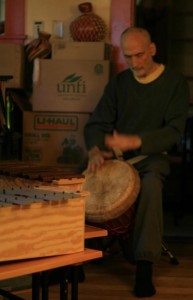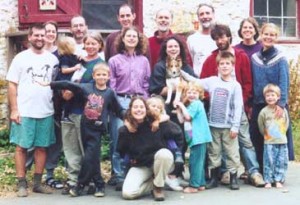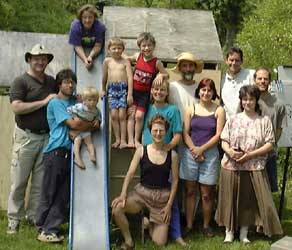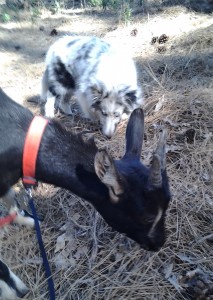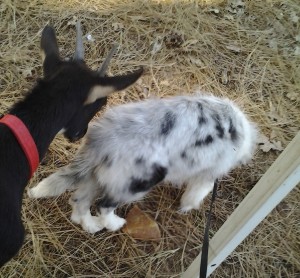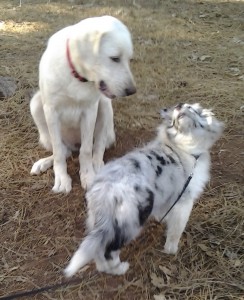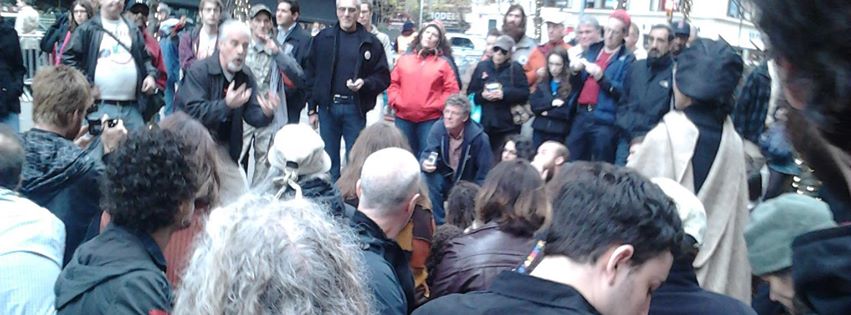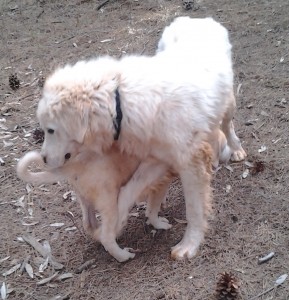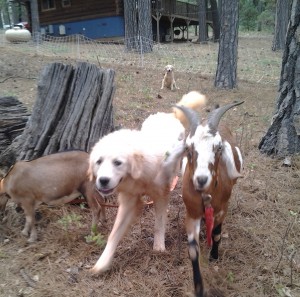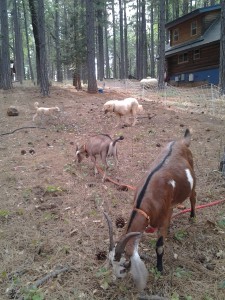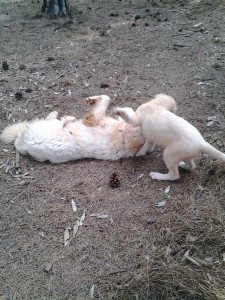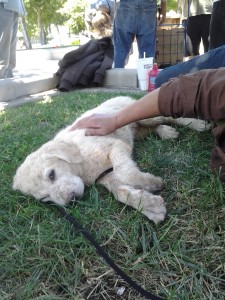Charles Curtiss: A Pause for All Symphonies in the Ether, Unwritten
He arrived home after a flood to find me, a stranger, on hands and knees in his garden. I was a visitor to Heathcote Community and I had been assigned work exchange: the task of picking up gravel that had washed into the main garden from the parking pad. Charles had been traveling and we hadn’t yet met. He was one of the community gardeners and he stood, taking in the damaged plantings with shock. I tried to imagine the love and effort and hours he had given to this garden, now washed away. But as I observed him being unable to speak for some time, I also wondered if he was just one of those intense, dramatic people who always played moments like this. I would have the next two decades to learn that he was not. We lived together in drama and boredom, work and play, love and loss. Today I learned that Charles is gone.
 Charles had been a professional musician, a drummer, in a band that had a record contract but didn’t get far. He’d studied at Berklee but left before finishing in his version of the typical rebellion/not fitting in story. In community, he made his music a gift to all by teaching World Music Drumming classes and accompanying our singalongs with his guitar.
Charles had been a professional musician, a drummer, in a band that had a record contract but didn’t get far. He’d studied at Berklee but left before finishing in his version of the typical rebellion/not fitting in story. In community, he made his music a gift to all by teaching World Music Drumming classes and accompanying our singalongs with his guitar.
Leaving the rock & roll life for a career in Montessori seemed to have given Charles a sense of balance and span. He cultivated his identity as a “Sensitive New Age Guy,” reading and discussing the latest pop philosophy book and stretching to acknowledge his privilege with humor and humility.
He often talked to me about Lisa, the child who had been in his life and gone. She was a partner’s daughter, and when that relationship ended, it was the loss of Lisa he mourned most.
Since we both wanted to have a child, we briefly did a dance, imagining having one together. But that is not a relationship we would have.
One thing he shared with Lisa, and then used as therapy when she was gone, was his obsession with trains, real and toy. He had constructed a model train set that ate up most of his apartment and discretionary income, once upon a time. Since my dad also built a sprawling train universe in my childhood basement, I understood train therapy and enjoyed Charles’ stories. To this day, when I see a train, I think of him.
But his time at Heathcote was filled with other therapies: gardening, cooking, ever-flowing meetings. Charles was a pilgrim on a search and he thrilled at including visitors, friends, kids and community mates in his explorations and gentle curiosity of what it means to be human, gendered, ethical, accountable, alive. He took to wearing the same simple clothing most of the time. It added to his persona that one ex-Heathcoter had labeled his “icky priest.” Even as he smiled at the characterization and repeated it in jest, he also worked to temper the ego that gets fed by the pilgrimage itself.
Charles was anti-shack. Our guerilla structures were energy inefficient and he felt we should comply with all local codes. The individual hippie shacks exposed the community to potential trouble. I personally didn’t want to live in a group house. When he decided to move into one of Heathcote’s empty shacks so he’d have room for his music studio, he was the first one to make jokes about his hyprocracy. But eventually the zoning trouble did come, and I did leave the community rather than live in a group house. I can’t say I believe he saw into our future, but I believe he wanted the community to be more secure.
His sense of security was fed by a strongly independent, “bootstraps” streak. He didn’t want to burden his friends or the community. So, as he lived with Parkinson’s and his life shrank into the Farmhouse, decisions about what he could and couldn’t do, and what help he would ask for, were difficult for him. He was always clear with us that he would leave to be with his family in the end.
It was Charles, in his confrontational honesty, who helped me understand that my community and my friends there had turned in a direction I couldn’t follow, or, even if I had done the turning, it was time to part.
 As I page through our years at Heathcote in my mind, I light on our interactions, his judgements of me, his struggling with his judgements of me, my pulling back from our friendship when he got sick with Parkinson’s because I felt it was all I could do to badly take care of myself. And, because I have been a Heathcoter, I notice how much of my memories of us appear in a frame about me. Now I want to take the time to look at Charles—always setting aside funds for his next car; taking time to draw out a visitor’s life story; attending every monthly work day; mediating countless checkins with presence and gravity; taking constant public account of his life lessons and failings. He was a pilgrim for our times.
As I page through our years at Heathcote in my mind, I light on our interactions, his judgements of me, his struggling with his judgements of me, my pulling back from our friendship when he got sick with Parkinson’s because I felt it was all I could do to badly take care of myself. And, because I have been a Heathcoter, I notice how much of my memories of us appear in a frame about me. Now I want to take the time to look at Charles—always setting aside funds for his next car; taking time to draw out a visitor’s life story; attending every monthly work day; mediating countless checkins with presence and gravity; taking constant public account of his life lessons and failings. He was a pilgrim for our times.
—Wren
P.S. Charles appeared by name at least twice in my poetry. I like that these show the pilgrim I knew:
Broom Zen
Charles’ mother is dying.
He has planed
800 miles.
Now he sweeps
her kitchen.
Back home this is his
after-dinner chore.
He sweeps the hall,
2 seconds per stroke
by the mantle clock.
“Get the stairs while
You’re at it,”
his father says.
He sweeps the living room
and the porch.
He sweeps the lawn.
His mother is awake.
She asks of his plans.
He talks of job changes.
She takes out 3 papers
and crunches numbers
on the first.
Charles makes
clarifying calculations
on the second.
She rests.
And Charles waltzes the broom.
He spreads out the pages–
her handwriting, his;
the choreography of cursive.
And one more…
He takes the unused page,
with a pause for
all symphonies in the ether,
unwritten,
and drags his dustpile
onto the page
with his mother’s broom.
—WT
walking meditation
the walking meditation class is poised
watching pumpkins swell
watching crow’s feet creep
time lapsed
photography
to chronicle
an epic
of an
opening orchid…
a sunset…
high tide…
or charles remembering that
if you walk slowly enough
you need only stand still
—WT
Subscribe to this blog's RSS feed
Deep Democracy: Thinking About Safety in Groups

Occupy San Francisco members accompany a health inspector at their encampment, with mainstream press and lifestream coverage.
How “safe” are your groups for diverse people, operational styles and opinions? How safe do you feel in groups? How about right now? The concept and importance of safety in group dynamics can be elusive. We might be looking for a definition we can all depend on, but in fact, safety is defined by the person who doesn’t have it. It’s individual, subjective and momentary.
It’s also seated in the gut. So much so that we’re often not intellectually aware of our safety or lack of it. We’ve all felt those hairs on the back of the neck sound an alarm. Safety can be as physical as a fight-or-flight situation. But for some people, often people who lack privilege, the absence of safety is a low grade static state. It might be marked by what the person doesn’t say, what the person doesn’t do.
Some people are eminently safe in groups. They’re often the first to speak and often have the “great idea” to solve a problem. But even these individuals can fall out of safety in moments.
Many people don’t think of themselves as “out of safety,” but during meetings they speak very little because “it’s just not worth it,” or “someone else will say it,” Or, maybe as a woman or person of color, or anyone who’s seen repeated group dysfunction, they view a group as “nothing new/same-old-same-old” in which others are oblivious to what life is like for her/him.
In the groups you belong to, do newcomers check out the group but leave after a few meetings? In meetings, do the same 3 or 4 people do most of the talking, with 3 or 4 others speaking once, and the rest just listening, as if watching a TV program? Does it seem like a tiny core group do 80-90% of the work of your group, with a large membership who are just “tourists” or “consumers,” enjoying the fruits?
Most people say that these dynamics are just the nature of groups, that this is to be expected. But are you sure? Have you ever interviewed a new member who left your group? Would that person tell you the truth? Is there a way to increase participation? How significant is the question of safety?
Fiopa Consensus Collective
fiopa@consensus.net
I wrote the handout above as a conversation starter for small groups at the beginning of a workshop we held at the library in Chico, California. I’m not really blogging these days but I have been cleaning up my computer files and thought I’d share some writings here. You’re welcome to share the above, only if you credit Wren Tuatha & Fiopa Consensus Collective, and do not alter the content.
–Wren Tuatha
Horns & Fangs Are just Outies and Innies
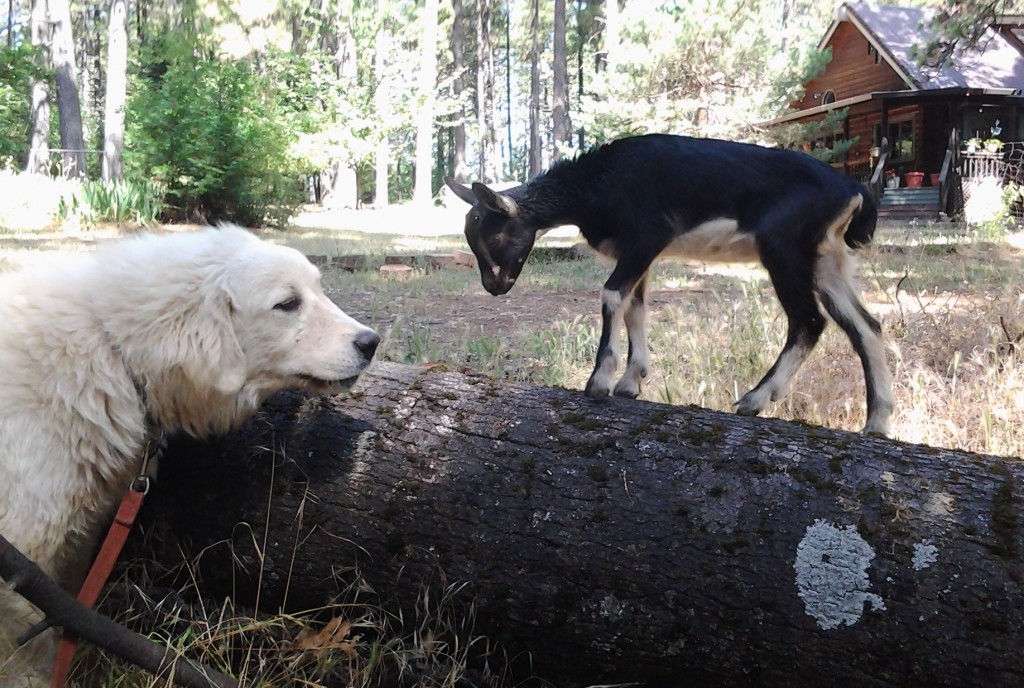 C.T. and I have been in our log kit home in the Sierra Nevadas for just over a year now. Reflecting on nearly two decades of cooperative living at Heathcote, I still long to be back in an Intentional Community.
C.T. and I have been in our log kit home in the Sierra Nevadas for just over a year now. Reflecting on nearly two decades of cooperative living at Heathcote, I still long to be back in an Intentional Community.
Has it happened organically around us here? ”We have eleven mouths to feed every day,” C.T. just observed this morning. Let me count that out:
Me
C.T.
Floyd, the landlords’ horse
Shiloh, a puppy we’re petsitting
Leeloo, our cat
Cricket, our Sheltie
Tonka, our male Akbash
Dana, our female Akbash
Ponder, our bottle baby goat
Guru, our big horned wether
Story, our middle sized goat
Yep, eleven. We smiled to think of our rag tag group being the community we wish we had. Of course, it’s not “Intentional Community” in two core ways: It’s heavily hierarchical and no one but the humans and the cat can be said to have chosen it. All the others were. shall we say, kidnapped, or at least recruited without their input. Neither did existing members get to weigh in on new arrivals, just us humans. So structurally, it’s more like a family, with parents choosing to add children.
Goats and dogs are considered to rely heavily on hierarchy in social groups. Although that’s not their whole story, it’s not untrue. And in our big family, hierarchy plays out every hour.
At the bottom of the goat ladder is Ponder, our bottle baby Alpine. She had rough beginnings, and is the smallest. She’s also very Mama-focused, which creates jealousy and also inspires her to do ungoatlike things. Guru constantly bullies her, like a drill sergeant trying to build a better soldier.
Ponder was the first arrival and Tonka was the second. When he got of of the car and saw the little baby goat he was brought to protect, he fell in love. Ponder is closer to the dogs than the other goats as a result.
So she’s always been curious to make friends with our little Sheltie, Cricket. Let’s list the ways this has not gone well:
1) Cricket broke her hip as a pup and fears being pushed or knocked down, which can be painful
2) Ponder, like Guru and Story, has horns
3) Goats gently butt heads/horns to say hello
4) When Ponder gets close to Cricket, intending to butt hello, she realizes she’s bigger than the dog and has an opportunity to dominate someone else. She can’t resist, and the hello becomes a die, demon scum!
I’m mama to both so when I sit with the herd, Cricket and Ponder both want to sit in my lap or at my feet. Die, demon scum plays out, over and over. When Cricket sees the various goats head butting or just chasing after each other as they leapfrog from one pile of hay to another, she barks an alarm. To her, horns equal violence and goats must be stopped. But she’s just eleven months old. She has a long time to learn to appreciate goat subtlety.
The combined goat and dog group has an overall hierarchy, apart from the goat and dog specific lists. They respect that dogs are just goats that have their horns in their mouths (innies) or that goats are just dogs with their fangs on top of their heads (outies), depending on perspective.
The ladder goes something like this:
Tonka–Normally livestock guard dogs should be below their goats or sheep, serving them while not being aggressive toward them. But after some early issues with food aggression and some bad moods overnight in the barn stall, The others give way to Tonka, who is gentle and patient with his charges. Now.
Guru–Not a lovable brute like Tonka, Guru is more like that curled mustache/dressed in black bad guy from the Old West, tying damsels to train tracks while speaking in a strangely out of place British accent. He’s strong as a pony but his dominance comes from endless micro aggressions. Being much larger and older than the does, he has several responsibilities: watching for danger, teaching the others what to eat and what to avoid, punishing bad goat behavior and advocating for the group to the humans.
comes from endless micro aggressions. Being much larger and older than the does, he has several responsibilities: watching for danger, teaching the others what to eat and what to avoid, punishing bad goat behavior and advocating for the group to the humans.
Story–We often call her the little serial killer. She’s constantly looking for ways to bully ponder and anyone else down the line. But it’s not random. She has the most to lose. Being only slightly heaver than Ponder, she could actually lose her place as second goat.
Ponder–In two separate bullying events, Guru broke the tips off both of Ponder’s horns. This had an interesting effect: She now has sharp, knife tipped weapons which she loves to use on:
Dana–Dana is happy to occupy the traditional livestock guard dog place under the goats. Other than play fights with Tonka and barking at deer and jackrabbits who dare to threaten her charges, she is never aggressive. But just when she falls off to sleep or gets a comfortable spot under a tree, here comes Ponder to poke the one herd member she can.
Cricket–Don’t hurt me, don’t hurt me. Goats are just wrong. Dana, let me stand on your head. I’m big! Whee, I’m fast! Don’t hurt me, don’t hurt me. Goats are just wrong. Mama…Whee, I’m fast!
Enter The Green Butler
 C.T. Butler Launches New Eco-Friendly Cleaning Business
C.T. Butler Launches New Eco-Friendly Cleaning Business
If the economy is recovering, the wave hasn’t hit our house. As C.T. pursues work as a personal assistant, I have wondered how I could contribute. Since my health prevents me from working, I can pass my skills on to others. Enter The Green Butler!
Early in my time at Heathcote Community in Maryland, I attended film school and supported myself as Walden Tribe Cleaning. I cleaned homes and offices using vinegar, baking soda, vegetable-based detergent, hot water and elbow grease! I used cotton rags instead of paper towels and other disposables. Eventually, I had several cleaners working for me and over a hundred clients. When health problems interfered with my cleaning, I moved on to other projects. But now I am sharing my knowledge with C.T. so he can launch The Green Butler, an eco-friendly cleaning company serving our new home, the Chico/Paradise/Magalia area of Northern California!
Of course, his business name is both a play on C.T.’s surname, Butler, and also his career as a personal assistant (a kind of modern day butler) to high net worth individuals. In his role as personal assistant, he supervises household staff, including housekeepers. He’s usually a conduit between client and household staff, and handles hiring, payroll and other employment issues. He’ll continue to perform these tasks for The Green Butler.
Until we have a staff for C.T. to supervise, he will clean the growing schedule of houses and businesses himself. I have been sharing my knowledge and experience with natural cleaners and the standard tasks and flow of the job. He’s a great student. It’s a fun role reversal for us, as I came into our partnership as his consensus student. Now I get to go along behind him and give the thumbs up or say, “You missed a spot!”
Tabling at Chico Natural
In the old days of Walden Tribe, I only needed to post my pull-tab flyers at Baltimore’s Whole Foods and a few other grocery stores. Between that and word of mouth, I never lacked for clients. Since bulletin boards are no longer ubiquitous, C.T. pulled an old strategy from his activist days, an information table. In Chico, the place to be is Chico Natural, the local food coop. He’s had great success meeting interested people and setting up bid appointments. And the coop has great snacks…
Conventional thinking might hold that, in a tight economy and a challenged area like Butte County, few Chicoans would be in the market for a luxury service like house cleaning. In fact, it’s more recession proof than you’d think. As people may be paid less, they often work longer hours. Many people, especially parents, decide to hire a house cleaner so their shrinking free time can be used for other pursuits–time for relaxation, time with children or pets; hobbies or activism.
As with Walden Tribe, new Green Butler clients cover much of the economic spectrum. They’re telling us they’re relieved to have help because these days it’s almost impossible to keep up with everything.
In the Walden Tribe days, about half of my clients preferred my natural methods and half didn’t choose me for my environmental angle, they just appreciated that Walden Tribe did an excellent job. In Chico, people are consistently excited to have an alternative to conventional services and their mainstream chemical products. It looks like we’re filling a valuable niche!
In addition, most have been pleasantly surprised at our affordable bids.
Spring Growth
C.T. has been cleaning professionally for about two weeks now. He’s motivated to grow the schedule quickly. So friends and neighbors in
Chico, Paradise and Magalia:
SIGN UP FOR WEEKLY OR BI-WEEKLY CLEANING AND GET YOUR THIRD CLEAN FOR FREE!
Call me, Wren, for a bid appointment: 410-458-2310. Offer good through April 30, 2015.
For TRIBE: Choosing Intentional Community–The Values Process
Hello, TRIBErs! The following is the text of Fiopa Consensus Collective’s brochure on our facilitated process to help groups identify, define and use their commonly held values in a Values-Based Consensus process.–Wren Tuatha
The Initial Values Process
How a Group Identifies and Defines Values Held in Common for Values-Based Consensus
You are beginning a journey, an experiment. No one in your group has been through this before. Wren Tuatha and C.T. Butler (aka Fiopa Consensus Collective) want to take this time to outline the entire process of how a Values-Based group identifies and defines the common values that will become the basis of its decisionmaking process. You’re receiving this pamphlet at the beginning of a multi-meeting, ongoing process. The initial journey of coming up with a working list of values will take several weeks, and involve individual reflection, one-on-one checkins, small group discussion and large group consensus decision-making.
STEP ONE
Individual Want/Need Values Exercise
You’ll be given a list of “value words” to prompt your imagination. It is in no way a complete list, just examples of the “meta” words that represent values. Unless you arrived late, you will be given at least 20 minutes for the following process, which is done individually, in a quiet environment.
You’ll hear how values differ from goals, strategies and outcomes. “Green Building,” is a strategy for practicing the value of “sustainability,” for example. We’re only looking for the values underneath our goals, strategies and outcomes right now. You’ll get to that other content later.
Make two columns on a piece of paper. Label one “NEED” and the other “WANT.”
In thinking about the group you’re forming, what values do you personally hold that you need to be group values, they’re your non-negotiables; without them, you might not be able to be in this group. List them under “NEED.”
Which of your values would you like to be common, but if they’re not, you’ll be able to adjust. You won’t have to leave the group, but you think they’re important. List them under “WANT.”
[Note: C.T. Lawrence Butler’s book, On Conflict and Consensus, lists and defines these eleven values as being inherent and embedded in the structure of consensus: Trust, Respect, Unity of Purpose, Nonviolence, Self Empowerment, Cooperation, Conflict Resolution, Commitment to the Group, Active Participation, Equal Access to Power, and Patience.
If you don’t resonate with one or more of these values, consider referring to the book for C.T.’s definition. If you’re still uncomfortable after discussing it with group members, it is likely the consensus process is not for you. You’re not out of the game, though. Consider form- ing your own group that uses voting, Sociocracy or some other method of decisionmaking, and form a coalition for actions in conjunction with this group.]
STEP TWO
Form a Committee to Collate Values onto a “Values Wall”
This committee will collect everyone’s Need/Want lists.
- Every value that is on every paper, whether a Want or a Need, is automatically common.
- Next, values that members put on their Need list, if not already identified as common, will be collected and the committee will ask the group, at a subsequent meeting, if any of these could be common values. If everyone who had not already identified this value would add it to his/her own list, then it is common.
- If anyone declines to include this value, discuss it’s meaning to the people who listed it and to the people who reject it. No movement? Maybe it’s not a common value, and the person who needs it may not be a candidate for membership in this group. Or maybe it is a common value and the person who rejects it is not a candidate for membership in this group.
- Next, the remaining values that are on anyone’s Want list which are also on most but not all papers are brought to the group. Are they common values?
Individuals Define Values on Wall
The committee will take the list of common values, which will probably number between 12 and 50, and write them on giant paper on a large wall space to which all members have regular access. The value words will have ample space for each member to write their own definitions. Every member need not define each value, but should define all that are important to the member, as inspired. The definition can take the form of dictionary language, examples, poetry, rap lyrics, pictures or whatever gets the ideas out. Important: Each member must put her/his name to his/her definition. If another member wants to ask a question, she/he needs to be able to find you. This is a slow motion dialog.
STEP FOUR
Committee Wordsmiths Definitions
After a predetermined and announced period of time, the values wall is closed. The committee takes what was written on the values wall for each value word and wordsmiths them into a definition for each value, contacting members with questions on their offerings, as needed. Like all VBC meetings, the committee announces to the whole group when and where it will meet, and their meetings are open to all members.
STEP FIVE
Group Reaches Consensus on Definitions
The committee brings their wordsmithed definitions to the group in small batches, 2 or 3 values per meeting. If the whole group consents to the wording of the definition, the committee’s work is completed for that value for now. If the definition fails to reach consensus, the committee continues to wordsmith the definition using the feedback from the whole group. This process continues until the whole group reaches consensus on each of the definitions. It is important for the group to appreciate that this is hard work and give it’s committee much love, not attacks, for their efforts.
- • Your group will likely need to make decisions before your initial values work is done. You can use the 11 val- ues defined in the book, On Conflict and Consensus, as a temporary common values base until your initial val- ue process is complete. Trust the process and everyone’s good intent using the VBC model. (Never skip Levels 1, 2 or 3.)
- Your group will indentify additional common values from time to time.
- More often, your group will need to adjust and add to its definitions of existing common values as situations bring new aspects to light and priorities shift within the individual members and as a whole group.
- Do make a large, readable poster with your common values (just the words) in a “cloud” or non-linear list. Use different colors of ink. Hang this in your meeting space for every meeting.
- Do have your values and their definitions in a binder that is in the room at every meeting. Make updates promptly as your definitions and values list evolves.
Fiopa Consensus Collective
fiopa@consensus.net 410.458.2310
Nice Review of Consensus for Cities
Thanks to Pablito of Reclaiming Quarterly for this positive review of C.T. Lawrence Butler’s Consensus for Cities! This is a pre-Occupy Wall Street review, of the proof edition C.T. circulated. He had planned to further edit it before the final print. But when we got involved with Occupy, we sold out of/gave away the five hundred proof editions and printed another run of five hundred. I just noticed this write up today. —Wren Tuatha
Consensus for Cities
A forthcoming book by C.T. Butler
Reclaiming-tradition groups often make decisions by consensus, and may be familiar with C.T. Butler’s pamphlet: On Conflict and Consensus.
His upcoming Consensus for Cities both deepens and broadens participatory decision making — to cities, community groups, and families.
Don’t let the title mislead you — consensus for cities is only one of several valuable ideas and discussions therein.
Cities lays out a detailed structure for consensus decision making for up to 100,000 people. If you want to know how many hours per week you’d spend and in what type of meetings, it provides a thorough and surprisingly tolerable estimate. The book also descibes a parallel mediation structure for disputes which are not easily resolved through the decision-making structure.
Cities’ discussion of and design for healthy volunteer-oriented community groups feels immediately relevant, useful, and democratically respectful. Other nonprofit management literature often focuses on hierarchical management and boards to the detriment of volunteer power, intelligence, and energy. If you have or are starting a community group, this book is worth reading.
Is the “family of the future” structured like an affinity group? Why might adopting consensus actually increase conflict? What is the psychology behind each formal consensus step?
Butler deepens his earlier consensus work by addressing these and other questions. Charts, definitions, and facilitation techniques are clear and useful for consensus practitioners.
Consensus for Cities is soon to be available from Food Not Bombs publishing, where you can also find a downloadable version of On Conflict and Consensus. Visit www.consensus.net.
— Reviewed by Pablito / Reclaiming Quarterly Issue #100, p. 7
Notes from Wren: The website, www.consensus.net, is offline for renovations. Watch for its return in 2016! Also, you might be wondering how to acquire Consensus for Cities. Just contact C.T. Butler at ctbutler@together.net or 301-586-2560. Just found this interesting assessment on a youtube discussion thread:
“This problem is why consensus is being increasingly adopted. It holds all the stakeholders accountable to the group and provides a level structure for negotiating right and need to access. C.T. Lawrence Butler’s “Consensus for Cities” provides good models for scaling the process up, so that accountability and responsibility are not restricted to the immediate group. This way, an isolated group can be held accountable to worldwide stakeholders, i.e. no one could overconsume at others’ expense.”
—enkiduslover
Food Not Bombs and Polyamory
I’ve been working with my partner, Food Not Bombs cofounder and consensus author C.T. Butler, on writing about his life. We’ve been mapping the overlaps of activism and personal life. Of course for C.T., the personal is always political and the political is immediate and personal. He tells stories of the first Food Not Bombs collective, a group of activists who had met while occupying the construction of Seabrook Nuclear Power Station.
Forged in the crucible of early punk, the collective was youthfully recreating the sex, drugs and rock & roll meme on their own terms. They practiced polyamory, although that word had not been coined yet. And they brought a feminist form of consensus to their collective. In her 2010 book, Polyamory in the 21st Century: Love and Intimacy with Multiple Partners, Deborah Anapol records some of C.T.’s stories, intersecting sex and politics:
C. T. Butler, who is now in his fifties, has lived polyamorously and been actively engaged in working for social change for his entire adult life. In 1981, he cofounded the Food Not Bombs collective, which is still going strong around the world as a grassroots organization to provide free vegetarian meals for the hungry and raise awareness about homelessness as well as protesting war and military spending.

C.T. reports that for two years in the early days of Food Not Bombs, the collective was run by three men and three women who shared a large house and whose relationships included sexual involvement with each other in one way or another. They went so far in challenging the status quo that they had the experiment of not having their own personal bedrooms in the house. C.T. recalls, “Downstairs, we had the kitchen, dining room, living room, and study; upstairs, we had the sleeping room, the sex room, the library/meditation room, and the music room. We all slept together in one big bed in the sleeping room, and sometimes, some would sleep in the sex room or music room. There were others moving in or moving out of the collective all the time.”While many of the young people who formed the Food Not Bombs collective were already lovers, they were “seasoned activists” who viewed their sexually radical lifestyle as a precaution against infiltration. C.T. re- calls that “we were quite concerned about infiltration at the time and felt that the willingness to be sexual and deeply intimate with everyone else in the collective was a way to prevent infiltration. Obviously, we did not think it was absolutely foolproof; we just thought it was helpful. However, that does not mean we required everyone to have sex with everyone else in the collective; it was that we were interested in experimenting with sexual relations in an outside-the-box way, and we saw the usefulness of this ex- perimenting in strengthening our bonds and our effectiveness as political activists. Therefore, in practice, if someone was unwilling to experiment, they were not suitable collective members. If they were comfortable with open relationships and had a willingness to experiment sexually, as dem- onstrated by their behavior, then we assumed they were very unlikely to be an agent of the state.”
In keeping with their anarchist politics, the collective were strong adherents of consensus decision making. Any member could call a meeting called a group-group, where everyone would engage in a discussion that could not end until everyone agreed on a resolution, which might mean two or three days with breaks only for eating and sleeping. C.T. reports that these group-groups were called only maybe five times in two years to address things like “dealing with a sexual predator, kicking a member out, and sexism.”
C.T. says that jealousy was never much of a problem for him because of his “political analysis of life.” He explains that, “from early adulthood, I realized that possessive behaviors and the idea that one person could control the behavior of another because of the concept of marriage was really just another form of slavery, one person owning another. I have never wanted to control or have another person all for myself. With regard to the jealousy my partners would feel, I was very patient and clear that jealousy is primarily based on fear. I would take the time to help my partner uncover her fear and manage it so that it would either go away or, at least, not destroy our relationship. Generally, that worked pretty well.” During the 1980s and 1990s, he helped start polyamory discussion groups throughout New England, lived in a series of polyamorous families, and fathered several children. For C.T., polyamory was as much a tool for political activism as a means of personal gratification.
One factual correction: Although C.T. “parented” several children, as in helping to raise them, he only fathered one child.
Interestingly, we discovered that C.T. is listed among famous poly people in the German Wikipedia article on polyamory. He pops up on lists here and there, often on lists of notable vegans or vegetarians.
As I post this, we are helping Cricket, our puppy, negotiate her play relationship with Leeloo, our cat. Cricket stands over her, trying to swallow the cat in slow motion, head first. Leeloo objects by biting and clawing Cricket’s leg.
“You have to check in with your partner, Cricket. Leeloo’s not having fun. Learn the signals,” I say.
“Yeah, you can’t just chew on ‘em,” C.T. concludes.
Great relationship advice from a poly activist…Decades of experience that you can take to bed…Meanwhile, Leeloo needs a safe word.
Moving Company Scam
Life lessons, sigh. I had never moved across the country before. C.T. and I made the decision to lessen our work and stress by hiring professional movers, even though our money was beyond tight. In my Internet searches I got lists of moving companies and reviews, most of which I now realize are fake, written by employees of the movers. I wish I had searched on the keywords, “interstate moving scam,” before the move. That’s when I learned that what happened to us is a manipulation run by many moving companies and that they operate in the sweet spot of overcharging just enough that legal action isn’t worth it, and the governments don’t come after them because they play states and federal jurisdictions against each other. Sweet spot, indeed. The scam in summary: Your moving company gets you to sign a contract that estimates your weight but they somehow get a weight ticket showing that your household weighs much more than it does, and you must pay thousands more or they will not release your belongings to you. Our story, in general details: After inquiring by email with several companies, C.T. got a call from Colonial Van Lines. The expeditor on the phone said all the right things, that our household goods as described by C.T. probably weighed X amount, and that the company would move us for X dollars, just barely within our budget. Colonial present themselves as brokers, who then hire actual carriers to move your belongings. This was an indulgence for us, but we wanted our move to go well and we felt that having professionals load and drive our possessions was the way to have a smooth move! Soon other employees of Colonial started to call us with issues that would add costs to our bill. First, they decided our stuff weighed more. Then they called to say they couldn’t get the large truck on our street and we would have to pay extra for a shuttle truck. We rejected both these claims. Unfortunately, our contract said that we would not get our deposit back if we cancelled within, I believe, five days of the move and here we were, within five days. Interesting that they suddenly had these concerns then! Then we started getting similar calls from the middle men, the carrier Relo, who would actually move our goods. Our move was going to weigh more, plain and simple. We got scared that the move would cost money we didn’t have. We had to stay on budget. So we opened up boxes, gave away more things, threw things out. We consolidated small boxes into big boxes because, at one point, the callers stressed that it was the number of boxes, not the weight. Then we did something the movers probably didn’t expect: We actually bought a scale and weighed just about every single thing that we own. We stayed up until two in the morning the night before the movers came. We knew we were right at our target, give or take a couple hundred pounds. We knew what our belongings weighed. The Relo crew brought the shuttle truck at no cost to us. We were impressed to watch the crew of movers work. They were skilled, strong and seemed to be taking great care wrapping our furniture, at least while we were present. The crew chief seemed nice and showed us a ticket from a weigh station, showing what the truck weighed before our household was loaded. It seemed like things would work out fine. A day or two later, we got a call from that crew chief telling us that our belongings weighed three thousand pounds more than the contract. Having gone to great trouble to weigh our load, we contested this immediately. We asked for a reweigh, with us witnessing, but we were told the truck was already on the road. We had our own journey to manage, taking a dog and a cat from Maryland to California in a sedan, getting delayed by snow in the mountains. During our five day drive we tried to reach people at Relo and Colonial by phone but we got nowhere on the reweigh request. Once we arrive at our empty rental house in California, we began a period of endless days of phoning, arguing and pleading with people from Colonial and a third company called Atlantic Van Lines, who claimed to have been hired by Relo or Colonial somewhere enroute. This is where the good cop/bad cop play comes in. As far as I can tell, all three companies are the same company. Colonial, the brokers, played good cop, being on our side and trying to represent our interests in getting a reweigh. Atlantic, or Relo or whoever, they were the bad cop, threatening to keep our possessions, threatening to sue us, telling us what a bad company Colonial is and pressuring us hard for thousands more dollars. Just to clarify, the customer is always entitled to a reweigh, at any point on the journey. It’s against the law for a mover to deny you this. Finally the two sides pretended to no longer be working together. Atlantic said they didn’t need to honor any contract signed with Colonial. Colonial played the high road and assured us that Colonial would refund and overcharges themselves and that we should pay the overage. As a matter of fact, A Colonial vice president advised us to rent a different truck, pay the overage, load our things onto the new truck and go immediately to an independent weigh station. We did exactly that, incurring all the related additional charges. Our household belongings weighed exactly what we said they did. Our weigh station weight was in line with the total we got when we weighed each box and piece of furniture on a scale back in Maryland. Here the smoke and mirrors continued. Colonial had us send them all documentation, claiming that they were pursuing legal action against Atlantic on the behalf’s of us and several other clients. We were assured a refund. And the weeks and months rolled by. We had needed that money to live on once we landed here, while we looked for work. Life was hard financially without the money we’d been swindled of, and all of Colonial’s answers to our calls were vague. We are still being told our money will be refunded very soon. Why not just sue them, you’re asking now, right? Yeah. Colonial claims to be based in Florida, and our contract states that any legal action has to be brought against them there. After consulting with lawyers and government officials in California, Maryland and Florida, we found that we would indeed have to sue them there. We are actually willing, but the fees for filing small claims in Florida are higher than the other states, by several times. It’s an ongoing process, as is pursuing criminal action in Maryland. Long story long, the three companies are one group that does this regularly to folks completing interstate moves. Their Florida location and the good cop/bad cop routine protect them well. And who would sue when the cost of doing so roughly equals what they’re stealing? Aparently, these loopholes are the result of deregulation of the trucking industry. A few movers get caught. I did see one article about a moving company owner doing serious jail time. A person or persons in this organization has committed serious fraud with a regulated scale. But I have found that my state of origin and my state of arrival are slow to pick up this banner. Fortunately I have time on my hands to be a squeaky wheel. Lesson learned? Move yourself? Well, buyer beware, at least. Perhaps avoid so called brokers. Definitely drive to the weigh station and witness the before and after weighs of your truck. And read the Moving Rights and Responsibilities handbook carefully before signing a contract with anyone. It’s long, but it’s trying to tell you something. If your contract requires you to pursue legal action in a certain state, research the ease of that. Personally, now that I’ve picked up some moving techniques watching pro’s wrap and pack my furniture, I plan to rent a truck and hire friends in the future. I will travel with my truck. And I will pray for swift karma all around. That people can get away with this says very pathetic things about humanity and our culture.
Latest Simplicity Complication: Goats’ Guard Dog Sleeps All Day and Barks All Night
The first thing I read about Livestock Guard Dogs barking is that the last thing you want to do is stop them from barking. Well, fine, but the rancher who writes this advice must be amid a thousand acre spread somewhere in Oklahoma. She or he doesn’t have my very sleep deprived neighbors!
Kids will be kids, or some such. We love our eight month old Tonka, who’s doing a great job of keeping our goats safe from deer, foxes, neighbors chatting on their decks, dogs on the opposite ridge, neighbors hammering unknown things in their own yards, and other dangers only he has identified.
Not to make light of potential threats. One chatty neighbor came off his deck to warn us he’d seen the bear around. He was sure that our goats were attracting the bear and a mountain lion he’d heard vocalizing down the
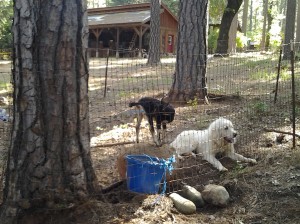
Tonka cools off in foxholes dug under his water bucket. This one in the nursery pen doubled as an escape route.
canyon. The neighbor wanted us to know that he was armed and that if we had any trouble, we could call him and he’d come over and shoot the trouble for us. Thanks. Do you think I could get away with it if I told the next bill collector, “Please put on this bear suit and wait here. I have a phone call to make…” I guess that’s just mean.
So what to do about a giant barking pup? Well, first, understand that he’s not a pet in the conventional sense. He’s more livestock. Yes, we spoil him and we’re not going to eat him, but still, he’s more like livestock, in that he lives with the herd, sleeping in the barn. We need it to stay that way. He’s a working dog with a job and night is a crucial time on his job.
Most advice in books and online has been for pet dogs. These writers assume that the dog lives with people in a house with a yard. Their advice assumes these things, too. Even so, I’ve tried to adapt the best advice to our situation.
All of the advising writers agree: Understand the reason for the barking and make your training relevant to that. At first, when Tonka shared the barn with just Ponder, our tiny bottle baby goat, we humans spent more time with them. Tonka is so playful and outgoing. It was easy to get drawn in.
But making Livestock Guard Dogs human-focused is a no-no. And we quickly saw that his barking, in day and night, was wanting our company.
So we quickly got more goats, a second, younger pup, and ample fencing. Tonka matured and calmed down instantly. He now wrestles with the pup instead of mauling the bottle baby. He walks his perimeter hourly and surveys for trouble. He’s chased away curious foxes and lots of deer.
He also sleeps like the dead. In the middle of the day. In a foxhole that’s becoming the size of a swimming pool. I assume the depth of his sleeping is in part due to the fact that he’s still growing. He’s a teenager and human teenagers, well, they need a lot of sleep.
Tonka and the herd overnight in the barn that’s between our cabin and our landlords’ cabin. We share the herd with our landlords, and thus, we started by barking corrections at him from the cabins on either side of the barn. Sometimes one of us would throw on clothes and trek out to the barn to make sure everything was okay. Whatever fantasy we had of strangling him so we could sleep would melt away to coos and reassurances when we would see that enormous, innocent head, breathing hopefully at our approach.
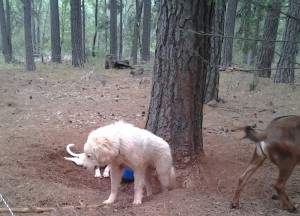
Tonka climbs out of his current foxhole, which he shares with Dana and Ponder, the bottle baby he protects from typical goat hazing.
We changed the bedding. We brainstormed expanding the stall. Soothing music. I even spent several nights in a row sitting in the dark for hours, a few yards from the stall, ready to correct each bark and reward his stopping. Everything we tried had this in common: It worked at first, then stopped being effective.
At this point, he’s forming this as habit, or even a game.
My partner, my very sleepy partner, C.T., noticed Tonka sacked out in his foxhole a little while ago, passing away the heat of a summer midday. “Retribution!” C.T. called. He had the idea of tossing pine cones near the sleeping dog, keeping him awake as payback and also as a way to insure Tonka would be sleepy tonight. He gathered up pine cones and took position. I watched from a bathroom window. Incoming One: It landed three feet from Tonka’s nose. No response. Income Two: Landed just outside the electric netting. No movement. Incoming Three: Bounced off subject’s right ear. Subject unresponsive. Mission: Failure.
I know dogs typically sleep about sixteen hours per day, and that they rarely sleep through the night. I’ve lived with dogs all my life. But Tonka’s youth, and maybe the summer heat, are challenging me right now. I tried exercising him more. This can’t do me any harm, either! But a walk around the land didn’t wear him out. His breed doesn’t like fetch. Too bad; That’s always worked for our Sheltie.
I’m ready for drugs. I can see this going several ways. First, the drugs are either for the dog or all the humans in the neighborhood. Then, he or we get uppers for the day and downers for the night.
The saddest part is that Tonka is the wise one here. We live in the mountains above Chico, California. Every summer the college students vacate and Chico rolls up its streets like other college towns. We keep being told that this event or that organizing should wait until the students get back. This has always seemed strange to us because few if any students come to the events we’re discussing. But we’ve slowly come to understand that Chico, in the wide open valley, becomes an intolerable oven in the summer. Saying wait for the students to come back is a euphemism for wait for Chico to awaken from its sun coma. It’s too hot to think.
Tonka has it right. We humans structure ourselves, scheduling year round, filling the time with do, do, do. We have forgotten siesta time. Or worse, we make some racist association with lazy Mexicans or other desert dwellers who simply know that our schedules-of-European-decent won’t work here.
Don’t think I can sell that to the neighbors of European decent. Tonka’s getting drugs!
—WT
Humans Are Exhausting
Dana, our Akbash Livestock Guard Dog pup, is getting used to people. When she came to us a week ago, she had mostly bonded to the goats and dogs in her herd of birth. She came with two of those goats and she quickly made friends with our bottle baby goat and our eight month old LGD. But she just begrudgingly tolerated us human types.
Other than a quick visit with the landlord’s grandchildren, her first exposure to people other than her handlers was last Saturday’s Food Not Bombs public feeding at Chico, California’s City Plaza. Suddenly she was surrounded by cars, adults, children, lapdogs, and the Chico summer heat.
Our Sheltie Tuatha came along as he does most Saturdays. He seemed to enjoy initiating Dana to the public fountain, a great way for furry folks to cool off. Dana got plenty wet, but she mostly just watched the human children jump through the spray while Tuatha barked at the water.
After a few interactions with humans, Dana being passive, as if leaving her body, she finally started to approach people proactively and she seemed to enjoy their touch and talking. By the end of the event, a very tired, wet puppy laid next to our friend Lisa, who gave her more touch.
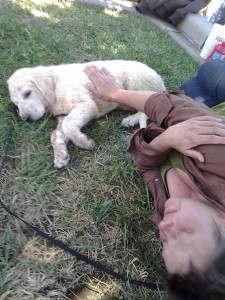
Dana, wet from playing in the fountain, snuggles with her new human friend, Lisa, as the Food Not Bombs feeding winds down.
A few days later, Dana went with me to the feed store and One Mile at Chico’s Bidwell Park, where hundreds of people were cooling off in a pool. Dana was fine, trotting along with me on her leash, no longer doing that puppy death pull. She was curious about people lying down sunbathing, but not enough to trot right up and introduce her cute self. But when one woman with a large family fell in love with her, Dana got lots of attention.
After these trips out into the human world, Dana sees me and runs to me, behavior she wasn’t doing before. Just today, she sought me out and let me rub her belly for several minutes. She does play posture with me and generally has accepted me as part of the herd. Instead of pretending that my partner C.T. is invisible, she’s interested and affectionate.
How will she be with strangers as she matures? As an LGD, she has the genetic programming and early socialization to be wary of strangers until her humans show that they’re acceptable. If her deformed paw or other circumstances determine that she will be a general farm dog or even a pet, we want her to have good human socialization.
